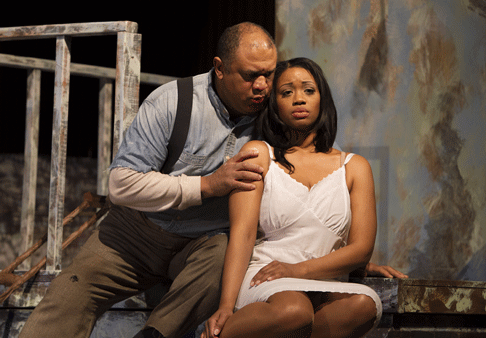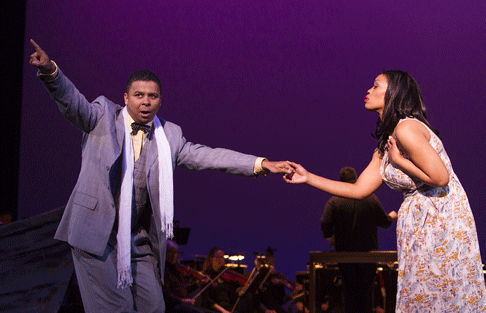Syracuse Opera returned to the grandeur of the 2,117-seat Crouse Hinds
Theater Sunday for its 2013-14 season-closing production of an adaptation of
Gershwin’s theatrical masterpiece, Porgy and Bess. (The company’s
two earlier chamber-sized productions, The Tragedy of Carmen and
Maria de Buenos Aires, were housed at the more intimate Carrier
Theater.)
Proponents of The Gershwins’ Porgy and Bess champion the
truncated version as a vehicle better suited to live theater, which may be true
— although purists are likely to disagree. But judging from the over-the-top
ovation by the near-capacity crowd at curtain call, I’d say this version
appears to be perfectly sufficient. Moreover, Sunday’s performance was, by
any measure, an artistic success.
Syracuse Opera had been publicizing this one-time only event (there was no
repeat performance) as a “semi-staged” production. Come curtain time,
however, the audience discovered that it ain’t necessarily so. This
performance had the look and feel of a full-blown staged production, complete
with costumes and stage action. If it didn’t capture the substance of Catfish
Row, at least it captured its essence — and soul. Except for the placement of
the orchestra at the back half of the stage (instead of in the pit) and a
static set that did not change, this was a complete operatic experience. And a
handsome one, at that.

One reason for the success of this production was Syracuse Opera’s
decision to engage Hope Clarke, the first African-American to direct and
choreograph Porgy and Bess both here and abroad. Clarke’s directorial touches
included enlisting the 44-member Syracuse Opera Chorus as active participants
in the musical numbers. The chorus, well prepared under the direction of Chorus
Master Joseph Downing, swayed, danced and waived their arms high into the air
during numbers such as Oh, I can’t sit down — at times resembling
a revivalist church gathering. Clarke’s ensemble spirituals and laments were
handsomely composed on the stage, and her poignant staging of Robbins’s wake
was truly touching.
Another reason for the company’s success was the direction of the singers
and instrumentalists by Douglas Kinney Frost. Conducting the orchestra with his
back to the singers, Frost — aided by display screens strategically placed at
various parts of the stage — managed to juggle competing forces with no major
mishaps. (It customarily takes a performance or two to work out the kinks.)
Frost had just one shot to get it right — and he did.
Perhaps the single greatest reason for the production’s success was the
quality of the acting and singing. Ironically, it was the supporting roles that
impressed me the most — particularly Michael Redding (Crown), Aundi Marie
Moore (Serena), Brittany Walker (Clara) and Jorell Williams (Jake). The
performances by the principals were strong, but uneven.
Laquita Mitchell is no stranger to the role of Bess, having sung (with Eric
Owens as Porgy) in the 2009 Francesca Zambello production at San Francisco
Opera. Mitchell looked the part from the moment she took stage — drugged out
and slinking across the floor much like the way Maria describes her: a
“liquor guzzlin’ slut.”
Mitchell was in excellent voice throughout the afternoon, using her darkly
tinged soprano to great effect in What you want wid Bess, sung while
trying to get out of the clutches of the abusive Crown. Mitchell’s acting,
however, was less persuasive. She could not project her character’s agonizing
ambivalence in choosing between the man who accepts and loves her and
Sportin’ Life’s happy dust.

As the proud cripple, Porgy, Gordon Hawkins sang with a hefty baritone that
easily projected throughout the large hall. Like Mitchell, Hawkins had
performed the role in a Zambello production (Chicago Lyric Opera, 2008). He
forged a commanding stage presence from his very first entrance and his acting
skills were thoroughly convincing. But Hawkins’s vibrato Sunday was
uncomfortably wide — especially when singing in full voice or at the top of
his range. This in turn muddied his words and rendered his diction virtually
unintelligible, as was evident in his third act lament, Bess, o where’s my
Bess.
Victor Ryan Robertson fashioned a suitably flamboyant Sportin’ Life,
Catfish Row’s friendly neighborhood drug pusher who presses Bess to come with
him to Harlem and live the high life. Looking especially unctuous in Costume
Designer Jodi Luce’s colorful three-piece brown suit (with ample pockets to
hold his stash of happy dust), Robertson tickled the crowd with his
cunningly innocent revision of Biblical history in It Ain’t Necessarily
So. Robertson’s pleasant tenor, though not strong, was always enjoyable.
He was the only singer whose diction remained crystal clear throughout the
performance.
Baritone Michael Redding as the villainous Crown gave a standout performance
in this production. The Atlanta native used his entire body to craft a
believable character who was both fearless and frightening. (His menacingly
diabolical laugh alone was enough to terrorize the God-fearing denizens of
Catfish Row — and the listener.) Redding’s voice is strong, richly hued and
attractive to the ear — as was clear from his cocky number, A red-headed
woman and his duet with Mitchell at the conclusion of What you want
wid Bess (which for me was the highpoint of this production). At curtain
call, Redding seemed surprised when the resounding applause at his entrance
soon turned to boos (the ultimate compliment for a villainous role
such as Crown).
Soprano Aundi Marie Moore delivered a strong and commanding vocal effort as
Serena. This is a role Moore knows well, having sung the part at the Virginia
Opera and Atlanta Opera, and it showed. Her superb delivery of the lament
My man’s gone now — sung with great depth of feeling at the wake
of her character’s husband, Robbins (killed at the hands of Crown during a
craps game) — engaged the listener in a true “lump-in-the-throat” moment.
Among the minor roles, Brittany Walker’s Clara delivered the spiritual
Summertime in a clean lyric soprano darkened with some pronounced
mezzo timbres, although she tended to end her phrases somewhat abruptly. As the
fisherman, Jake, Jorell Williams sang with a strongly defined baritone in the
rowing song It take a long pull to get there. Larry D Hylton, who did
double-duty as Serena’s husband Robbins and the Crabman, hammed it up to
perfection in the comedic “Vendors Trio.”
As a conductor, Frost found tempos that were mostly on the mark and
well-suited to the abilities of the singers. The effervescent Overture
bubbled with joy, and the opera’s signature duet Bess, You Is My
Woman came off splendidly. I was disappointed, however, with his lethargic
tempo in the otherwise snappy There’s a boat dat’s leavin’ soon for New
York, which all but drained the pizazz out of Sportin’ Life’s
splashiest number.
The instrumentalists from Symphoria navigated Gershwin’s
demanding musical score with precision and maintained an excellent balance with
the singers and chorus at all times. The pernicious xylophone solo at the
beginning of the Overture (and several places later on) was played in
dazzling fashion by percussionist Ernest Muzquiz.
Those listeners who entered the theater wondering why an opera in English
required projected supertitles soon got their answer. In DuBose Heyward’s
novel, Porgy, from which the libretto is taken, the characters in
Catfish Row speak the Gullah dialect (English, with Western and Central Africa
inflections) common in South Carolina and other parts of the South. It’s
difficult to follow this dialogue intelligibly without the supertitles,
especially when diction is muffled as was the case here.
I’ve long wondered why a work with such a parade of catchy tunes and
colorfully orchestrated accompaniments would not have been a hit during the
composer’s lifetime. It wasn’t until 1976 that the full-score version of
Porgy and Bess was mounted (by Houston Grand Opera Company), and the
work never made it to the Metropolitan Opera stage until 1985 — some 50 years
after the opera’s premiere (on Broadway).
I attended the uncut Houston Grand Opera version on Broadway in 1976, and I
can tell you that next to Le Nozze di Figaro, it was the best four
hours of musical theater I can remember. But I don’t mind admitting that I
enjoyed this shortened version of Porgy. Regardless of the size of the
hourglass, Gershwin’s tunes still reach the ears from top to bottom.
David Abrams
CNY CafÈ Momus
[This review first appeared at CNY
CafÈ Momus. It is reprinted with the permission of the
author.]
image=http://www.operatoday.com/_U2G0031.gif
image_description=Scene from Porgy and Bess [Photo courtesy of Doug Wonders]
product=yes
product_title=Syracuse Opera’s Porgy and Bess Got Plenty O’ Plenty
product_by=A review by David Abrams
product_id=Above: Scene from Porgy and Bess
Photos courtesy of Doug Wonders